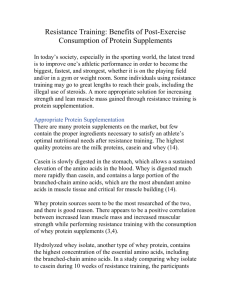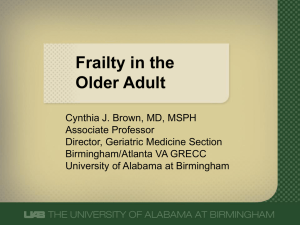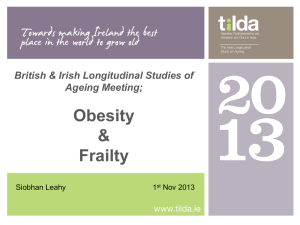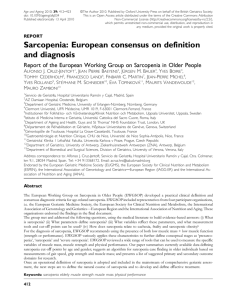Manuscript - Gerontological Advanced Practice Nurses
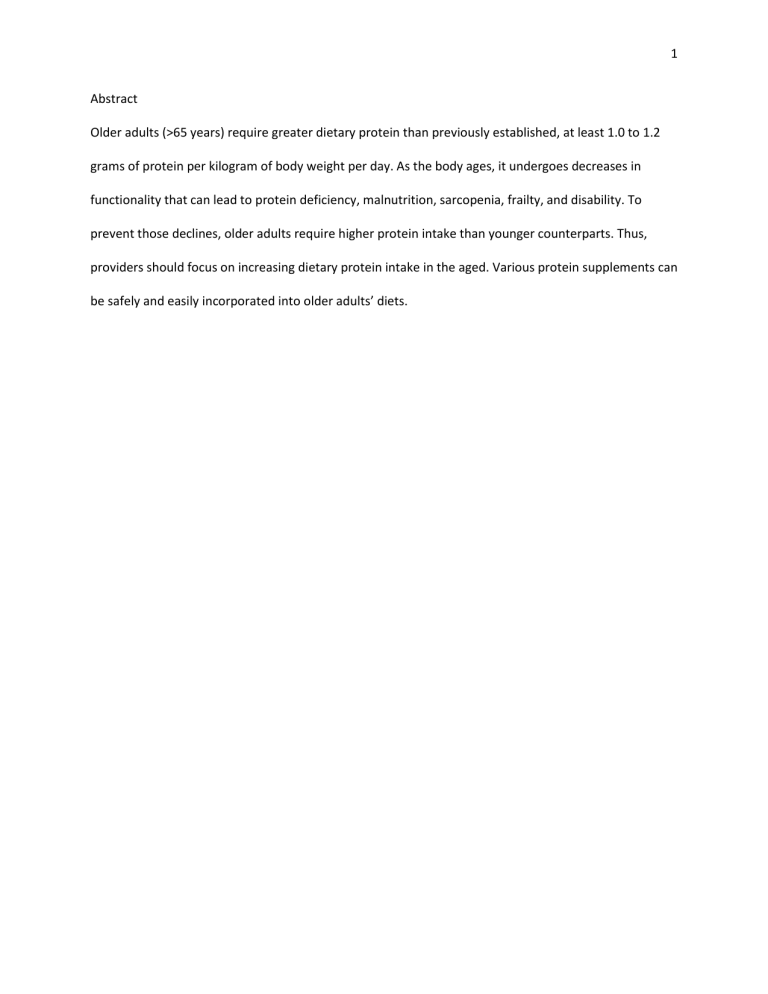
Abstract
Older adults (>65 years) require greater dietary protein than previously established, at least 1.0 to 1.2
1 grams of protein per kilogram of body weight per day. As the body ages, it undergoes decreases in functionality that can lead to protein deficiency, malnutrition, sarcopenia, frailty, and disability. To prevent those declines, older adults require higher protein intake than younger counterparts. Thus, providers should focus on increasing dietary protein intake in the aged. Various protein supplements can be safely and easily incorporated into older adults’ diets.
TITLE: Meeting Protein Demands of Older Adults to Prevent Frailty
AUTHOR: Andra R. Marosok, BSN, RN
29 Hemlock Dr, Lancaster, PA, 17602
marosok@musc.edu
2
Introduction
Given its effects on the aging process, nutrition is a critical component of health throughout the
3 lifespan, and especially in older adults (defined as age >65 years). Unfortunately, malnutrition and protein deficiency are increasing in this population, contributing to disability and premature death. For the last decade, increased efforts have been devoted towards preventative interventions against both age related sarcopenia and frailty.
1
Current evidence reveals that older adults have an increased dietary protein need that often is not met.
1 Nurse practitioners in primary care are crucial to increasing protein intake in the elderly.
Nutritional status and protein intake both need to be incorporated into routine monitoring. Protein supplementation alone may positively affect physical function, and higher protein intake combined with proper exercise may significantly adjust body composition.
Pathophysiology
Essential amino acids (AAs) are a nutritional requirement that must be supplied in the human diet as free AAs or through proteins. The physiology of hepatic and intestinal protein and AA metabolism in humans is unknown. Instead, we have results from trials involving mostly animals or humans with cirrhosis.
2 The liver and the portal-drained viscera (gastrointestinal tract, pancreas, spleen, and associated adipose tissue), termed the total splanchnic tissues, have a high rate of protein synthesis.
Functions of the splanchnic tissues have large requirements for AAs, and are sensitive to variation in metabolizable protein relative to specific AA requirements of the body. Splanchnic tissues play a key role in diet digestion, nutrient absorption, catabolizing surplus AAs, and other functions.
2 Aging causes blunted anabolic response to dietary intake and is believed to further increase splanchnic AA metabolism, consequently decreasing available AAs systemically. The exact mechanisms remain unknown.
3
4
The main physiological change associated with advanced age is a decline in skeletal muscle mass, termed sarcopenia. A major cause of sarcopenia is malnutrition or undernutrition. Progressive loss of muscle mass, reduced strength, and a decrease in endurance can occur. Frailty is a geriatric syndrome of reduced homeostatic reserves, increasing an individual’s risk of negative health outcomes of falls, disability, hospitalizations, and mortality. Physical function, especially mobility, is the key in determining extreme vulnerability. Sarcopenia still has a clinically unreliable definition, but frailty has been standardized by the Clinical Frailty Scale ©. This scale allows for an individual’s scoring of frailty and can be used as a reference for one’s progression or digression.
4 Nurse practitioners as providers must focus instead on interventions to prevent and treat both.
Findings
Inadequate protein intake relative to needs in older adults is multifactorial. In addition to a declining anabolic response to protein intake, the aging body also requires higher amounts of protein to offset catabolic and inflammatory conditions that are often associated with commonly occurring diseases.
5 Protein also is an important structural component of bone, and studies have shown a beneficial relationship between protein intake and bone mineral content/bone mineral density.
6 Older people consume smaller meals, eat more slowly, snack less between meals, and become satiated more rapidly after eating a meal than do younger people. The average daily intake of food decreases up to
30% from ages 20 to 80 years. This discrepancy in protein supply versus protein need may result in loss of lean body mass.
5
Diagnosis of Malnutrition in the Elderly
Characteristics to detect malnutrition and aid in its diagnosis have been established. Two or more of the following are required for diagnosis of malnutrition: insufficient energy intake, weight loss, loss of muscle mass, loss of subcutaneous fat, localized or generalized fluid accumulation, and diminished functional status measured by handgrip strength. Clinical judgement should be used when
5 considering the aforementioned characteristics. For example, older adults >80 years in age often maintain a lower than recommended body weight without affecting functionality. Other examples include acute illness or trauma and the accompanying metabolic stress.
4
Realistically, no assessment tool will ever reproduce the measured condition of sarcopenia, especially considering geriatric conditions that often muddle the effects of aging. Instead, physical function can be measured and represents the most obvious estimate of skeletal muscle quality.
1
Measurement tools should include hand grip strength and ambulation ten feet and back, when possible.
Protein Needs In The Aged
Traditional dietary protein intake guidelines were universally 0.8 grams of protein per kilogram of body weight daily (BW/d), regardless of age or sex. Newer evidence indicates that higher protein intake is required for adults older than 65 years to promote good health, recover from sickness, and maintain functionality. Older adults have a blunted muscle anabolic response to dietary proteins.
Moderate to large servings of proteins are needed to overcome this resistance in order to stimulate protein synthesis.
Daily dietary protein requirement in older adults is 1.0 to 1.2 g/kg BW/d. Older adults with acute or chronic disease require 1.2 to 1.5 g/kg BW/d and those with severe illness, injury, or marked malnutrition may require 2.0 g/kg BW/d.
6
Caution
Read all ingredients of the recommended supplements, in particular, products containing high fiber. Since this population has slowed gastrointestinal transit, fiber could cause constipation. Older adults on protein supplementation should be educated on proper hydration.
Exercise
National exercise guidelines for older adults are a minimum of moderate-intensity aerobic activity five days of each week. Also, muscle-strengthening exercises in moderate to high intensity should occur at least two days each week.
7 Weight training reverses sarcopenia in elderly men. Protein
supplementation is especially required for muscle mass gain during exercise training.
8 Exercise is recommended to meet the individual need and tolerance. Referrals to physical therapy are invaluable
6 for this reason. If tolerated, individuals should supplement immediately before, during, or after exercise.
9 Also to accompany supplementation, omega-3 fatty acids can stimulate muscle protein synthesis in older adults, thus verifying its benefit for the prevention and treatment of sarcopenia/frailty.
10
Whey
Essential amino acids required to stimulate muscle protein synthesis escalate with age. An evaluation of oral nutritional supplementation effects found that whey protein supplementation caused a higher rise in blood levels of total amino acids in contrast to casein protein in elderly subjects.
11 This effect on postprandial amino acid profiles is encouraging for stimulation of muscle protein synthesis in preventing sarcopenia in older adults. Another study incorporated whey, casein, milk protein, and egg protein as supplements found that positive effects of protein supplementation on muscle and strength gain.
12 The results reveal that whey protein is the best and most specific protein for older adults, due to its long-term effects on muscle mass, strength and functionality. Casein was found to be least helpful.
Protein Supplements
Products claiming high protein content on their labels are heavily marketed and competitive. A number of protein supplements can be safely and easily incorporated into older adults’ diets. The nutritional market is saturated with protein supplementation options. Protein types within supplements can include whey, milk protein, egg protein, egg white liquid, casein, and soy protein, as powders or liquids, in a variety of flavors. Protein supplementation should help to boost, not replace, regular meals.
Discussion
Age-related changes within the older adult can lead to sarcopenia, a leading cause of frailty in the aged. Although numerous underlying mechanisms allow for age-related decreases in skeletal muscle
7 mass, sedentary lifestyle and insufficient dietary protein accelerate the process. For muscle protein synthesis and protein breakdown inhibition, older adults must consume their recommended amounts of protein.
Skeletal muscle has proven to be greatly receptive to protein supplementation, especially when
>70% of daily intake is ingested at lunchtime. An increase in muscle mass and strength enables the older individual to maintain and/or regain functional capacity, thus reducing the risk of falls and supporting an active independent lifestyle. Nutritionists and nurse practitioner providers can help to tailor diets to patient preferences with the understanding that clinically, any food consumption is more nutritious than not eating.
Conclusions
Dietary protein intake of at least 1.0 to 1.2 g/kg BW/d is required for most adults older than 65 years. Dietary protein intake is a modifiable risk factor. Adequate protein ingestion and exercise should be addressed for candidates with, or at risk for, malnutrition. Latest research shows that higher protein ingestion and exercise supports health, stimulates recovery from illness, and preserves functionality in older adults. Subsequently, sarcopenia, frailty, and disability in this population can be prevented.
Providers must take action and familiarize themselves with available products on the market.
Preventing sarcopenia and disability in this population will require clinical guidance to meet increased protein demand. Given the variety in products, from powders to solutions, even people with dysphagia can be helped to meet their increasing need for dietary protein.
References
1.
Cesari M, Landi F, Vellas B, Bernabei R, Marzetti E. Sarcopenia and physical frailty: two sides of the
8 same coin. Front Aging Neurosci. 2014;6:192.
2.
Van de Poll M, Siroen, M, van Leeuwen, P, et al. Interorgan amino acid exchange across the intestines and the liver in surgical patients. Eur J Gastro & Hep. 2006;18(1): A1.
3.
Bouillanne O, Curis E, Hamon-vilcot B, et al. Impact of protein pulse feeding on lean mass in malnourished and at-risk hospitalized elderly patients: a randomized controlled trial. Clin Nutr.
2013;32(2):186-92.
4.
Geriatric Medicine Research. Clinical Frailty Scale. 2012. Retrieved from http://geriatricresearch. medicine.dal.ca/clinical_frailty_scale.htm
5.
White JV, Guenter P, Jensen G, et al. Consensus statement: Academy of Nutrition and Dietetics and
American Society for Parenteral and Enteral Nutrition: characteristics recommended for the identification and documentation of adult malnutrition (undernutrition). JPEN J Parenter Enteral
Nutr. 2012;36(3):275-83.
6.
Darling AL, Millward DJ, Torgerson DJ, Hewitt CE, Lanham-new SA. Dietary protein and bone health: a systematic review and meta-analysis. Am J Clin Nutr. 2009;90(6):1674-92.
7.
Office of Disease Prevention and Health Promotion. Chapter 5: Active Older Adults. 2015. Retrieved from http://www.health.gov/paguidelines/guidelines/chapter5.aspx
8.
Paddon-jones D, Campbell WW, Jacques PF, et al. Protein and healthy aging. Am J Clin Nutr.
2015;101(6):1339S.
9.
Tieland M, Dirks ML, van der Zwaluw N, et al. Protein supplementation increases muscle mass gain during prolonged resistance-type exercise training in frail elderly people: a randomized, doubleblind, placebo-controlled trial. J Am Med Dir Assoc. 2012;13(8):713-9.
10.
Cermak NM, Res PT, De groot LC, Saris WH, Van loon LJ. Protein supplementation augments the adaptive response of skeletal muscle to resistance-type exercise training: a meta-analysis. Am J Clin
9
Nutr. 2012;96(6):1454-64.
11.
Smith GI, Atherton P, Reeds DN, et al. Dietary omega-3 fatty acid supplementation increases the rate of muscle protein synthesis in older adults: a randomized controlled trial. Am J Clin Nutr.
2011;93(2):402-12.
12.
Luiking YC, Abrahamse E, Ludwig T, Boirie Y, Verlaan S. Protein type and caloric density of protein supplements modulate postprandial amino acid profile through changes in gastrointestinal behaviour: A randomized trial. Clin Nutr. 2015.

